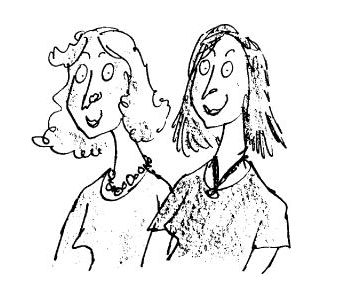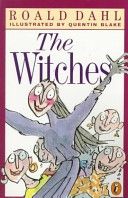The Witches
Roald Dahl and Quentin Blake (ill.)
Dahl, Roald; Quentin Blake (ill.);
The Witches
Puffin Books, 1983/1998, 206 pages
ISBN 0141301104, 9780141301105
topics: | fiction | children
I am convinced that this is the greatest Roald Dahl book.
Definitely one of the very best kid's stories of all time. BFG is a close second. But nothing else gets quite as far on the lunatic scale.
Excerpts
The most important thing you should know about REAL WITCHES is this. Listen very carefully. Never forget what is coming next.
REAL WITCHES dress in ordinary clothes and look very much like ordinary women. They live in ordinary houses and they work in ORDINARY JOBS.
That is why they are so hard to catch.
A REAL WITCH hates children with a red-hot sizzling hatred that is more sizzling and red-hot than any hatred you could possibly imagine.
A REAL WITCH spends all her time plotting to get rid of the children in her particular territory. Her passion is to do away with them, one by one. It is all she thinks about the whole day long. Even if she is working as a cashier in a supermarket or typing letters for a businessman or driving round in a fancy car (and she could be doing any of these things), her mind will always be plotting and scheming and churning and burning and whizzing and phizzing with murderous bloodthirsty thoughts.
‘Which child,’ she says to herself all day long, ‘exactly which child shall I choose for my next squelching?’
A REAL WITCH spends all her time plotting and scheming and churning and burning and whizzing and phizzing with murderous bloodthirsty thoughts.
‘Which child,’ she says to herself all day long, ‘exactly which child shall I choose for my next squelching?’
A REAL WITCH gets the same pleasure from squelching a child as you get from eating a plateful of strawberries and thick cream. Kindly examine [this picture]. Which lady is the witch? That is a difficult question, but it is one that every child must try to answer.

|
Examine this picture. Which lady is the witch? That is a difficult question... But it is one that every child must try to answer. |
Girl vanishes into picture
grandmother's story: ‘There was a family called Christiansen. They lived up on Holmenkollen, and they had an old oil-painting in the living-room which they were very proud of. The painting showed some ducks in the yard outside a farmhouse. There were no people in the painting, just a flock of ducks on a grassy farmyard and the farmhouse in the background. It was a large painting and rather pretty. Well, one day their daughter Solveg came home from school eating an apple. She said a nice lady had given it to her on the street. The next morning little Solveg was not in her bed. The parents searched everywhere but they couldn't find her. Then all of a sudden her father shouted, "There she is! That's Solveg feeding the ducks!" He was pointing at the oil-painting, and sure enough Solveg was in it. She was standing in the farmyard in the act of throwing bread to the ducks out of a basket.Sure enough - Solveg was in the picture. She was standing in the farmyard in the act of throwing bread to the ducks out of a basket. The father rushed up to the painting and touched her. But that didn't help. She was simply a part of the painting, just a picture painted on the canvas.’ ‘Did you ever see that painting, Grandmamma, with the little girl in it?’ ‘Many times,’ my grandmother said. ‘And the peculiar thing was that little Solveg kept changing her position in the picture. One day she would actually be inside the farmhouse and you could see her face looking out of the window. Another day she would be far over to the left with a duck in her arms.’
Boy turns into stone
‘[Another] was a boy called Harald,’ my grandmother said. ‘One morning his
skin went all greyish-yellow. Then it became hard and crackly, like the shell
of a nut. By evening, the boy had turned to stone.’
‘Stone?’ I said. ‘You mean real stone?’
‘Granite,’ she said. ‘I'll take you to see him if you like. They still
keep him in the house. He stands in the hall, a little stone statue. Visitors
lean their umbrellas up against him.’
on having baths
[witches can smell children who are clean]
‘I shall never have a bath again,’ I said.
‘Just don't have one too often,’ my grandmother said. ‘Once a month is
quite enough for a sensible child.’
It was at moments like these that I loved my grandmother more than ever.
---
Down vith children! Do them in!
Boil their bones and fry their skin!
Bish them, sqvish them, bash them, mash them!
Brrreak them, shake them, slash them, smash them!
[...
the kids have eaten magic powder,
which turns them into mice instanter.
a mousetrap now for every child
snappety snip into the wild!
...]
But not a single child in sight!
The teachers cry, "Vot's going on?
Oh vhere have all the children gone?
Is half-past nine and as a rrrule
They're never late as this for school!"
Poor teachers don't know vot to do.
Some sit and rrread, and just a few
Amuse themselves throughout the day
By sveeping all the mice avay.
AND ALL US VITCHES SHOUT HOORAY!’
Dahl on School education
In an interview with The Independent just before he died, he said, "Parents and schoolteachers are the enemy. The adult is the enemy of the child because of the awful process of civilizing this thing that, when it is born, is an animal with no manners, no moral sense at all."
Critical see saw, popularity unabated
from article in The Guardian (strongly recommended) The view of society revealed in Dahl's books, in particular his implied criticism of adults and his contempt for social institutions, has received mixed reactions from critics. The main charge levelled against Dahl's work it that his portrayal of life is unrealistic. However, it is arguably this very feature that appeals to his readers; the key to his success, as he frequently acknowledged, was to conspire with children against adults. The Oompa-Loompas in Charlie and the Chocolate Factory also became the target of much criticism, and various commentators have accused Dahl of racism on the basis that they represent African pygmies. More recently, critics have sought to puncture the Dahl myth of the subversive, anti-authoritarian figure, revealing the underlying conservatism and nostalgia of his books. Despite the change in his critical fortunes, Dahl's popularity with children and adults alike is enduring and in a recent poll he beat JK Rowling to the accolade of Britain's favourite author.
amitabha mukerjee (mukerjee [at-symbol] gmail) 2013 Aug 01
